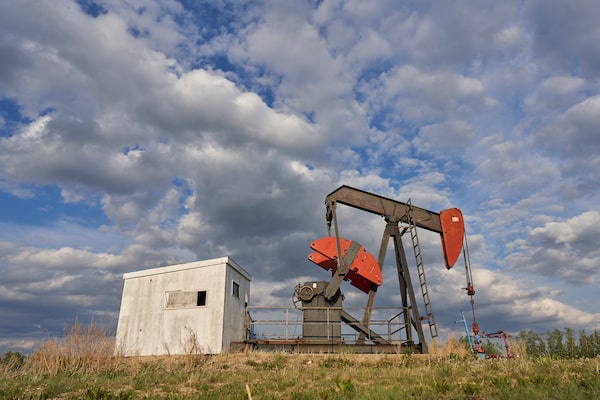
An orphaned well sits in a field near Red Deer, Alta, on May 24.GEOFF ROBINS/Getty Images
Alberta continues to mishandle end-of-life rules that govern inactive oil and gas wells, and the system the province uses must undergo an independent public inquiry to avoid financial and environmental catastrophe, according to a new analysis.
The research from the University of Calgary’s School of Public Policy, released Wednesday, focuses on Alberta’s Liability Management Framework. The authors conclude that the current regime fails to address a host of structural problems, including continuing secrecy and undue industry influence on the regulator.
As a result, they argue, the framework is unlikely to substantially reduce the number of orphan and inactive wells, nor uphold the polluter-pays principle, in which a company that pollutes the environment is responsible for cleaning it up.
Their report, titled A Made-in-Alberta Failure, written by researchers Drew Yewchuk, Shaun Fluker and Martin Olszynski, concludes that the province’s inactive and orphan oil and gas well problem is “an immense environmental and financial crisis that has been unsuccessfully dealt with by various policies over several decades.”
They found that industry has continually delayed vital work to clean up more than 170,000 inactive wells in the non-oil sands sector. That work comes with a price tag of at least $60-billion – and quite possibly double that amount, according to some estimates.
Yet the bill is largely unfunded. That’s because industry has not set aside enough money to pay for it, and successive Alberta governments over the decades have failed to require companies to post meaningful amounts of security, the analysis says.
“In the absence of significant and immediate legal and policy reforms, the coming years and decades will see the enormous environmental, social and economic costs of this regulatory failure fall on the province’s taxpayers,” it says.
Co-author Martin Olszynski, an associate law professor at the University of Calgary, said in an interview that Alberta’s unfunded oil and gas liabilities problem is “a complete regulatory failure.” And the first step in fixing it is a public inquiry to shine light on what happened and the options going forward, he said.
“This is a massive public-policy problem. We’re talking about anywhere from $60- to $130-billion of liabilities potentially falling on the public purse, doubling or tripling our current debt. And yet every decision that’s been made about it so far has been made behind closed doors,” he said.
Liabilities in Alberta’s oil and gas industry have been swelling for decades. The problem first became apparent in the 1980s, when a sharp decline in oil and gas prices resulted in a spike of sector bankruptcies. The Alberta Energy Regulator created an orphan well fund in response in 1986, and since then has taken various steps to try and reduce the environmental risks associated with inactive wells.
But by 2019, the number of wells in the orphan fund had skyrocketed and it became apparent that liabilities exceeded earlier estimates by huge amounts, dwarfing the amount of money the AER held in security for closure work. In 2018, internal AER estimates leaked to the media put existing closure liabilities for the conventional oil and gas sector at around $130-billion, though the regulator responded that the true figure was closer to $30-billion.
Mr. Olszynski said that kind of secrecy is just one example of the AER “consistently trying to downplay” industry liabilities.
“For the past 20, 30 years, there’s been a very strong bilateral collaboration between the regulator and the industry making decisions – essentially in tandem – about the design of this framework,” he said.
Asked whether it is transparent enough about the scale of Alberta’s liabilities issue, the AER said in an email that it has published information on how much the conventional oil and gas sector spent on closure activity in 2022, as well as progress on site clean-up.
It also pointed to new industry-wide requirements for spending and mandatory well closures, but did not address the criticism that it works too closely with the industry it is supposed to regulate.
The report says there are many such instances that point to regulatory capture at the AER, a phenomenon in which rules are consistently or repeatedly directed away from the public interest and toward the interests of the regulated industry.
“I think the regulator simply has essentially conflated: What is good for industry is good for us, and what is bad for industry is bad for us,” Mr. Olszynski said.
“Certainly it’s the case that the industry has brought a lot of benefits and prosperity to the province, but there was a bargain that was made and they appear to have been renegotiating that bargain for the past two decades, and in secret. That’s the part that’s really problematic. Albertans deserve to know more.”
Alberta overhauled its Liability Management Framework in 2020. To try to reduce the number of inactive wells, prevent wells from becoming orphans without a solvent owner and ensure timely cleanup, it introduced mandatory cleanup spending targets and a process whereby sites could be nominated for closure.
But the report notes that “without any form of timeline, yearly quota or penalties for non-compliance, closure obligations became a mirage constantly receding into the distance.”
The AER now estimates conventional oil and gas closure liabilities at around $60-billion (double its 2018 official estimate), but it holds less than $295-million in security as of July, 2023.
Earlier this year, Premier Danielle Smith tasked her new Energy and Minerals Minister with “developing a strategy to effectively incentivize reclamation of inactive legacy oil and natural gas sites,” and work with the AER to “improve and modernize” processes around a new Liability Management Framework.
Mr. Olszynski hopes the new report leads to an admission by the AER and government that the liabilities problem “has gone off the rails.”
“Doing more of the same isn’t going to cut it. There needs to be a radical change in direction, and to kick-start that radical change in direction we need radical transparency.”